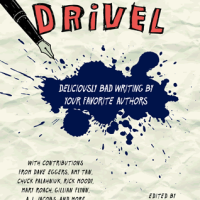Hi doggies, I’m so thrilled to be back in the Dogpatch!
As I’ve been entering my revisions for Dream of a City of Ruin (Book II of the Dreams of QaiMaj series), I’ve been thinking a lot about managing information in a novel.
Information is broad word so I’ll define it here as anything that the reader might need to know in order to follow your story. It might be backstory about a character, technical details about how something works, or the description of a setting. Lately I’m thinking the single most difficult part about writing, and the thing that ultimately separates “a book I’d like to read” from “a book I’d like to hurl across the room” is information management.
It’s a little like Goldilocks and the three bears: not too much, not too little. You have to include just the right amount of information for the reader to follow the story, without dumping in too much information, and you have to reveal the information so that the reader isn’t taken out of the story, so that your book doesn’t read like a technical manual, and so that your characters don’t sound like infomercials. It’s easy to fall into the trap of either including rambling, disruptive dumps, or trying to hide important information in a misguided attempt to create suspense, resulting in a lost and confused reader.
While there is no simple answer, I’ve picked up a few tools over the decades, from teachers, mentors, editors, peers and books on writing. For what it’s worth:
1. Kill your darlings, ruthlessly
It’s tempting to get carried away with including information. Chances are you’ve written pages and pages of backstory, world-building, research and character profiles. But just because you are in love with a particular bit of information doesn’t mean that it serves the story. Always ask yourself, does the reader absolutely need to know this particular information right now in order to follow and enjoy the story? If not, omit it. If a piece of information doesn’t either develop character or push the plot forward, we don’t need it.
Readers read fiction when they want a story, not a college textbook. If the reader isn’t already invested in the characters and plot, they aren’t going to care about how the hero’s gamma-ray gun works.
2. Prioritize information in order to determine how to reveal it
In order to understand how and when to reveal information, you have to have a sense of how important the information is to the story as a whole. You’ve likely heard the caveat that a gun on the mantle in Act I must be fired in Act 3. Well, the reverse is true. If something significant happens later in your story, you want to be leading up to it so that your reader is not so surprised by it that the story loses credibility. For example, if the villain is killed in the end by a gamma-ray gun, the reader should know both of the existence of such guns in your story world, and at least a little bit about how they function and how dangerous they are. Obviously, the presence of a weapon is a much more important piece of information than the details about how the fabric of the villain’s cloak was made. (Unless the fabric can teleport the villain, in which case we’d like to know something about it.) But the importance of some details isn’t as clear. So, how do you know what information in your story is going to be important?
3. Tell the story first
Whether you’re discovery drafting, outlining or summarizing, when you’re constructing your story, I’d advise you not to include any information you don’t absolutely need to craft a scene. That paragraph of backstory you think you need in Chapter 1—skip it. Chances are your information priorities will change by the end of your draft. When you tell the story first, you begin to get a sense of what is important and therefore what the reader will need to know, and when.
4. Choose key details: take cues from visual artists
It’s all well and good to wait and add in backstory and technical information later, you say, but what about the details I need to include now in order to build a scene? Character descriptions, setting, etc? I can’t very well wait and add everything in later.
As with backstory, description often falls into the too much or too little categories. To avoid either pitfall, take a cue from visual artists: when artists paint a picture, they don’t include every single thing their eye actually sees on the canvas. Of course, there are a wide variety of artistic styles, just as there are many different writing voices. A comic artist can tell a whole story with a few squiggly lines. But even the most photo-real painting is an illusion; the artist did not paint, grain for grain, what they saw in the real world. Instead they use lines and contrast to trick the eye into thinking what they are seeing is like the real thing.
In writing, you want to do the same thing. A lot of writers start to describe a character by listing every detail about a person, their height, eye-color, hair color, girth, etc. While it is important for you to know this information about your character, this doesn’t translate in the readers mind to a picture of the character. Instead, pick key details that leave the reader with a solid impression. Visualize what you are about to describe, and then ask yourself, what are three specific images that would best convey this setting or character? Limit yourself to those three impressions, and you won’t overwhelm the reader with information. And speaking of description . . .
5. Let me just debunk this “show don’t tell” myth
There are two basic ways to reveal information in your writing. You can either tell the reader information through exposition, or show the reader information through dialogue and action married with description. Most novice writers have been told over and over again to never tell, always show. This creates a false impression. It is actually vital to tell some details. If you showed every bit of information in your book, it would be five thousand pages long.
This is where prioritization of information becomes crucial. The reason why all those writing teachers told you to show is because if you tell something important like “her heart was broken,” you’re being lazy as a writer and cheating the reader of an immersive experience. On important things, you need to slow down: show what her heartbreak looked like, how it was written on her face, how her pace faltered as she passed her beloved’s grave, etc. On the other hand, it is perfectly acceptable to simply tell the reader that “She traveled for days before she reached the site of his death” providing that nothing extremely important happens in the intervening period. We don’t need to see every single detail of her journey. Telling is an essential tool for transitioning between scenes.
Another important role of telling is in revealing key information to create suspense. If I tell the reader that “The dragons of Lefian were particularly hungry after a long winter” right before my character encounters a dragon, the reader will be aware of the danger, whereas if I start by showing an aggressive dragon on the path, the reader won’t know why it is aggressive. Perhaps it is in pain and needs the character to take a thorn out of its paw (a much less dangerous scenario than a hungry dragon). When we’re not sure, we suspend judgement until we have more information; if we know ahead of time that the dragon is particularly hungry, our sense of danger for the character increases.
6. Never use exposition in dialogue
The Talking Heads are a great band, but they have no place in fiction writing. Whenever you feel the urge to reveal information via dialogue, don’t. Instead ask yourself, what would these characters really say to each other here? Chances are, it’s not “You see Bob, a gamma-ray gun works like this . . .” It’s probably more likely to be something like “DUCK!” In fact, I would even go out of my way to avoid putting information into dialogue when it is something a character would say. If you find you’ve written exposition in dialogue, just take the quotes off: Jane had already given Bob the three point lecture on how a gamma-ray gun works . . .
7. POV: your best friend and your greatest enemy
In many ways, POV will dictate what information you can and must reveal to your readers and when. For example, if you have an omniscient narrator, then you have the ability to convey any information you want the readers to have. But the great pitfall of an omniscient narrator is being tempted to include reams of useless information. If you have a limited POV, the information you can (and must) convey is limited to what your POV character knows. If something happens outside of your POV character’s scope, you can only convey it to the reader once your character learns of it. Likewise, however, if your character learns of something and you don’t then reveal it to the readers, they feel cheated. For example: “I whispered my plan to Bob. He nodded. ‘That’s a good plan.’ We moved out.” “I” implies a close first person POV, and we need to know everything your character knows in this situation. In fact, we should probably know it before “I” whispers it to Bob, because we’re in “I’s” head. Keeping the plan a secret here amounts to breaking POV, and the writer is probably missing a good opportunity to build suspense.
8. Deus ex Machina and the rule of three
Even when you include information, readers don’t always remember it; they haven’t read fifteen drafts of your work like you have. If a key piece of information is going to be relevant later in a story, you want to be sure that not only have you snuck it in ahead of time, but also that your reader remembers it. Otherwise, you risk leaving the impression of a deus ex machina (God from the Machine, or “I needed this thing to happen so I created a superpower for it”). DeM can shatter your reader’s belief in the story world.
To avoid an unwitting DeM, use the rule of three: mention anything that you want to stick in the reader’s head at least three times. For example, if you sneak gamma-ray guns into a few scenes, show them as a deadly weapon, and maybe even show someone being subdued or killed by one, then when your character kills the villain with one in act three, the reader won’t be incredulous. The rule of 3 applies in reverse as well; if a piece of information isn’t going to come into play in a big way, don’t mention it more than once, or at all if you can help it.
9. Don’t try to explain everything
I may have been slightly misleading when I stated earlier that “if the villain is killed by a gamma-ray gun, the reader should know at least a little bit about how they function.” In fact, the less you tell the reader about how gamma-ray guns work, the better. The more you try to explain things, the more questions are raised in the reader’s head. Our logical brains grab onto a factoid and immediately start rummaging around in our associative pathways for the information necessary to debunk it. “But what about this? But what about that?” If your reader is distracted from the story by trying to eradicate your logic, you will have lost them.
Instead of explaining how your made-up widgets work, you must simply convince the reader that they do work and move along with the story. How do you convince the reader that they work? By showing the widgets working, and above all by being . . .
10. CONSISTENT!!!!
This is the number one caveat for information management. Breaking consistency at any level skyrockets the reader out of the story. Consistency is a subtle thing, but it adds up to the sum of the reader’s suspension of disbelief. Showing the reader consistently that the story world and/or characters are a certain way is more convincing than any amount of backstory or explanations.
In order to manage consistency, keep clear records for yourself on every detail in your story. Have a reference to return to so that if you can’t recall whether gamma-ray guns leave the victim steaming or smoking, you can look it up. Peer readers can also be really helpful, they are always happy to point out where you’ve bungled consistency!
Well, there you have it, folks. Go forth and manage information tell your story.

















And it’s really funny. I’m sitting here editing a story to send with my application to Squaw Valley, and I’m loving the voice of this piece so much that I don’t want to cut some of the things that I love about it, even though I know in my heart that it’s most likely too much. It’s killing me!
Hi Selah,
Interesting post–thank you. I’ve been reading a friend’s novel lately (the unpublished manuscript, that is) and thinking about the show-tell balance quite a bit. One thing that occurred to me while reading the novel and then your post is that a certain amount of striking that point of “just right” has to do with trust and confidence–trusting your reader to “get” what you’re saying without hitting them over the head with it all the time (for those whose tendency might err on the side of telling too much) and trust in yourself, that you are conveying necessary information via situation/plot/scene/dialogue (without, of course, giving too much exposition via dialogue). I’m talking less about the kind of telling that is necessary for exposition and more the kind that is about expressing characters’ inner thoughts and emotions.
Anyway, that’s it for now–thanks for getting me thinking!
Wendy
Thanks for your thoughts Wendy! I agree, trust is tantamount, and therefor knowing your audience is key. Different audiences deduce your information at different levels.
Nice post, Selah! I appreciate a lot of what you say in this post and especially your comments about show/down’t tell. It’s so easy to toss out snippets of advice like that often-used term and then overlook what it fully means for using exposition across the distance of a novel. I’m a big fan of your work, so it’s great to know you’re organizing information for your next story!
Thanks Laurel! I think you taught me at least half of what’s in the post, so the credit ultimately goes to you : ) A big turning point for me in writing was learning that exposition is my friend.
Arf Arf! Thanks, Jilanne! I sure wish someone had explained that to me when I was in 4th grade : ) Thanks so much for having me, it’s an honor!
Pingback: Selah J Tay-Song » Barking from the Dogpatch again!
Selah,
Woofs to you! Great points! I’m so glad you talked about the showing vs. telling myth. I was just working with some 4th graders the other day, discussing their stories. One writer’s character took forever to get from one room to another, there were so many details. She showed everything. The story just died because there was no forward movement. So I gave her the suggestion that she start only with key actions that move the story forward—otherwise known as plot. She can fill in the details later. We’ll see if that helps.
And I’ve never thought about “killing your darlings” in the sense of unnecessary info that’s “fun” to have in the story for our own entertainment. We just love that bit about the six-toed cat wearing toe socks. But does our reader? It reminds me of Amy Tan saying that she tends to include things that aren’t essential to the story just because it amuses her. Good thing we all have editors—or beta readers. 😀
I do agree that consistency is key to holding everything together. My husband reads a lot of science fiction, and he is first to point out if something doesn’t “fit” in the world created by the writer. But I think it’s true for realistic fiction as well. Is you’re not consistent in your story, or if your character isn’t being consistent (for no good reason), then the reader’s not going to buy it.
Thanks for adding your thoughts to the Dogpatch!
Cheers!
Jilanne